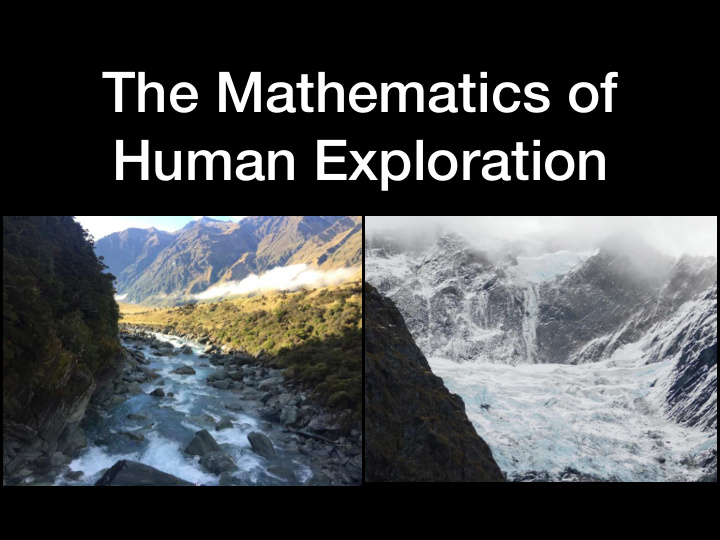



The Mathematics of Human Exploration
Four Objectives 1. Get students outside to develop a connection with their local environment so they become future stewards and sustainability advocates. 2. Emphasize mathematical questions and practice standards so students can produce unique research. 3. Give students the language to connect with the global community. 4. Restore my love of adventure, math, history, and teaching.
"You can often view glimpses of ingeniousness not as inexplicable miracles, but as the residue of experience. And when you do, the idea of genius goes from being mesmerizing to instead being actively inspirational.” -Grant Sanderson (3blue1brown)
Why Math? 1. Math is uniquely suited to international collaborations because of its status as a universal language. 2. Students are seldom given a true introduction to the field of mathematics: A. Make sense of problems and persevere in solving them. B. Reason abstractly and quantitatively. C. Construct viable arguments and critique the reasoning of others. D. Model with mathematics. E. Use appropriate tools strategically. F . Attend to precision. G. Look for and make use of structure. H. Look for and express regularity in repeated reasoning. 3. Student life trajectories are unpredictable, but it is certain mathematical understanding expands future options. 4. There are fascinating human stories behind discoveries we take for granted today.
Why Exploration 1. Humans have a long history of exploring that continues to this day: A. Wilderness/Oceans B. Space C. Research 2. Exploration is inspirational and allows for possible partnerships with NASA, NFS, NPS, and National Geographic. 3. It’s an excuse to get students outside and show the questions that arise from paying attention to one’s surroundings. 4. There are fascinating human stories behind past and current human explorations.
Time in New Zealand 1. Being an explorer myself through visits to wilderness areas and glaciers. 2. Discussions/interviews with leaders in the international climate and science communication communities. 3. Weekly attendance of climate and science communication courses. 4. Freedom of living in a society open to discussions on environment and climate- Te Papa for example. 5. Time to think, read, write, and learn.
My Product Mathematics of Human Exploration open-source research curriculum: https://pointsofdiscontinuity.com/
Next Steps 1. Begin the work of classroom implementation to create a proof of concept. 2. Finding contacts at the Green Mountain National Forest, White Mountain National Forest, and Acadia National Park. 3. Explore local wilderness areas by foot, bike, and ski, while employing di ff erent navigational skills/technologies to connect student math research with field experiences. 4. Present at a 2020/2021 Regional/National NCTM Conference and NZ Math Teachers Association conference. 5. Share this with Derek Smith, Ginny Wharoa, Robin Averill, Michael Drake, Dillon Mayhew, and James Renwick for outreach e ff orts. 6. Use my Colombia and NZ contacts to find “research partner classrooms” for international collaborations among students. 7. Work on a National Geographic grant to fund personal and classroom explorations (explorer-educator).
Recommend
More recommend